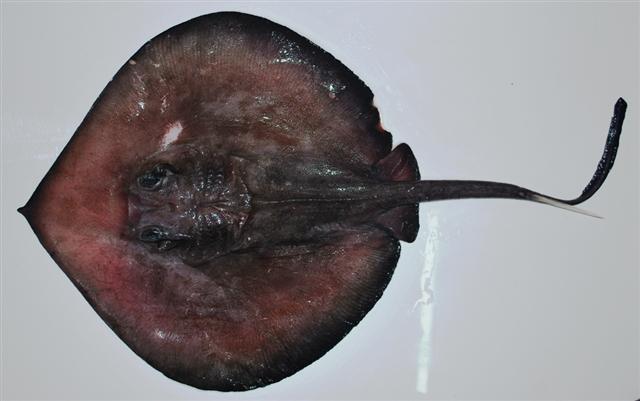Deepwater Rays
What are Deeowater rays?
The family Plesiobatidae, or deepwater stingrays, contains only one species, formerly included in the genus Urotrygon but placed in its own family in 1990. Deepwater stingrays are found on soft bottoms at depths between 44 m and 680 m. They are large, dark rays with a rounded disc that ends in an angular pointed snout. They are viviparous and likely share reproductive characteristics with Urolophidae (see Development and Reproduction). They feed on a variety of fishes and invertebrates (see Food Habits). They are not of interest to fisheries, and despite their venomous defensive sting, do not pose any threat to humans.The family Plesiobatidae consists of one species (Plesiobatis daviesi) of large, deepwater stingrays. Their pectoral disc is rounded and confluent with a broadly angular, pointed snout. The disc is slightly longer than it is wide, is grayish brown to black, and is covered with small denticles. The snout is long, with a lobe on its thin tip. The head is not elevated above the rest of the disc. The two spiracles (respiratory openings) are located close behind the ray’s small eyes. Their teeth are small and do not form flat crushing plates as do the teeth of some other rays. There are five pairs of small gill openings, and the internal gill arches lack ridges or filter plates. Deepwater stingrays have no dorsal fin, but they do possess pelvic fins and a moderately large caudal fin that extends to the tip of the tail. The tail is slender and almost as long as the ray’s disc, but is not whip-like. The large, functional sting is located about halfway down the tail. Deepwater stingrays measuring 2.7 m long have been reported.
Habitat
Deepwater stingrays can be found in marine waters near South Africa and Mozambique, Australia, and in the western Indian Ocean and the west-central Pacific Ocean from Japan to the Phillippines and Hawaiian Islands.Deepwater stingrays are bathydemersal (they live and feed on the bottom below 200 m). They occupy only marine habitats, at depths ranging from 44 to 680 m. They live on soft bottoms on the outer continental shelf and its upper slope.
Communication and Perception
Rays perceive and interact with their environment using sensory channels common to many vertebrates: sight, hearing, smell, taste and touch. Rays also belong to a group of fishes, the elasmobranchs, whose electrical sensitivity seems to exceed that of all other animals. Elasmobranch fishes are equipped with ampullae of Lorenzini, electroreceptor organs that contain receptor cells and canals leading to pores in the animal’s skin. Sharks and rays can detect the electrical patterns created by nerve conduction, muscular contraction, and even the ionic difference between a body (i.e. of prey) and water. In lab experiments, members of the family Urolophidae (which formerly included Plesiobatidae) changed their feeding location according to artificially induced changes in the electrical field around them. Other experiments have demonstrated that cartilaginous fishes use electrosensory information not only to locate prey, but also for orientation and navigation based on the electrical fields created by the interaction between water currents and the earth’s magnetic field. Although some rays can produce an electric shock to defend themselves or stun prey, members of the family Plesiobatidae cannot. They are able, however, to inflict a venomous sting with their tail spine in defense.
There's still so much more that you can learn about Deepwater Rays, though for now why don't you check out another stingray page.


